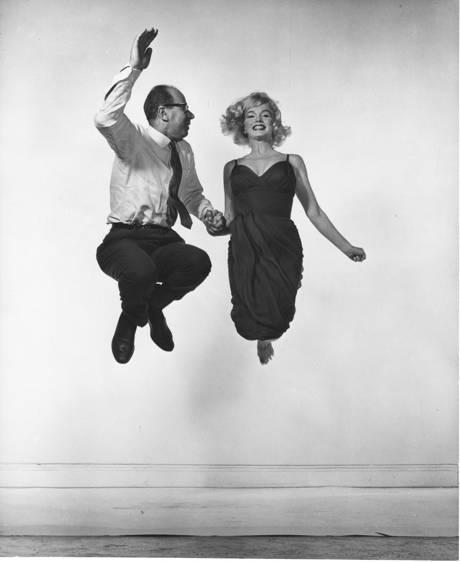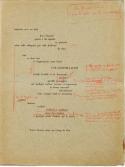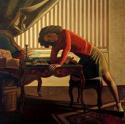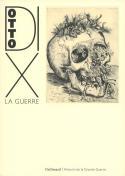Art Of The Day Weekly
#402 - from 15 October 2015 to 21 October 2015

Yvonne Halsman, Marilyn Monroe and Philippe Halsman, 1959. Archives Philippe Halsman © 2015 Philippe Halsman Archive / Magnum Photos.
IN THE AIR
The man who made Marilyn Monroe jump
PARIS - Philippe Halsman (1906-1979), a native Latvian who went through Paris before been naturalized American, also excelled in Surrealist compositions (Dali Atomicus or his multidisciplinary Cocteau with many hands), in manipulations and overimpressions as well as portraits (Malraux, Warhol, Hitchcock with the bird on his cigar being undoubtedly the most famous). He was a photographer with a n innocent face and elegant manners and suits. He even dedicated a surprising real-false interview to Fernandel. But this artist who could not be limited to one style, who produced 101 front covers of Life magazine, is known above all for his invention: to photograph his models while they jump up in the air. The duke and Duchess of Windsor, Audrey Hepburn, Maurice Chevalier and even Richard Nixon all played along and bent to this procedure. Not so Marilyn Monroe. The photographer followed her since 1949, but she gave him a very hard time. After a first refusal in 1954, the diva finally gave in in 1959. She jumped 200 times in one creative session and finally -of course- ended up on the front cover of Life magazine.
• Philippe Halsmann at Jeu de paume, from 20 October 2015 to 20 January 2016.
EXHIBITIONS
Balthus, the Roman
ROME – He is known for his paintings of great static tension, of immodest young girls in forms inspired from the Italian Renaissance. But Balthus (1908-2001), an asserted example of European cosmopolitism -with a Polish father, a Russian mother, his childhood in Berlin, his adult life in Paris and his senior years in Switzerland - also spent long years in Rome. He was the director of Villa Medici for seventeen years, from 1961 to 1977, and divided his time between his painter's career and the renovation of the institution. Two simultaneous exhibitions celebrate these different facets: his masterpieces -among them La Patience) - are presented at the Scuderie del Quirinale, his Roman passion (his work in the workshop, the renovation of the gardens) is of course documented at Villa Medici.
• Balthus at the Scuderie del Quirinale and at Villa Médicis, from 24 October 2015 to 31 January 2016.
Chagall, the musician
PARIS – The Philharmonie, recently inaugurated after a complicated construction period and a difficult opening, intends to prove that it will cover a wide spectrum, that will not be limited to concerts. Consequently, it offers a larger-than-life exhibiiton - 270 works including paintings, drawings, ceramics - which aims at analyzing the link between Chagall, a music-loving artist (in the shtetl at Vitebsk, his family included a great number of singers and violin players), and music, and this link is not limited to the ceiling of the Opéra de Paris, painted in 1964. The exhibition includes major moments such as the projects for Aleko in Mexico in 1942 or L’Oiseau de feu in New York in 1945), and it presents studies for the panels of Triomphe de la musique at the Metropolitan Opera in New York, which give their name to the exhibition. The famous panels from the Jewish Theatre in Moscow, done during the creative blooming of the beginning of the twenties, will also be present.
• Marc Chagall, le triomphe de la musique at the Philharmonie de Paris, from 13 October 2015 to 31 January 2016.

William Degouve de Nuncques, Mysterious Garden (My Garden), oil on canvas, 1891. Private Collection © Luc Schrobiltgen, Brussels.
Verhaeren, the go-between
SAINT-CLOUD - The title of the exhibition dedicated to Emile Verhaeren (1855-1916) hits the spot: the Belgian poet was indeed a remarkable go-between from literature to painting, carefully defending post-Impressionism with Signac and Cross or the Symbolism of Khnopff and Degouve de Nuncques. Paintings, drawings and prints, from van Rysselberghe to Maximilien Luce, document these links.
Emile Verhaeren, poète et passeur d'art at the musée des Avelines, from 15 October 2015 to 6 March 2016.
AUCTIONS

6 proofs of Un coup de dés jamais n'abolira le hasard by Vollard/Firmin-Didot, July-November 1897). Estimate: €100,000-150,000.
Mallarmé, chance up for sale
PARIS - A throwing of the dice will never abolish chance: the verse is well known and alone exemplifies Mallarmé's intelligent and symbolic poetry. In 1896, young Vollard (hardly 30 years old) and Mallarmé decided to publish an edition illustrated by Odilon Redon, with the printer Firmin-Didot. Mallarmé was very demanding and imposed various versions, of which each leads to a set of proofs in various copies, which he kept or entrusted to friends. Redon only started working in the spring of 1898. But on 9 September Mallarmé died. Vollard tried to carry this ill-begun adventure through but Firmin-Didot had destroyed the typographic shapes and the work was never published. There are only 18 sets of proofs left, among which this ensemble from descendants of the artist's daughter Geneviève. It is the most complete, since it includes six proofs. Hence the estimate, over €100 000. It is more conservative than it seems though: the Bibliothèque nationale de France, which already owns five versions, and the ambitious Houghton Library in Harvard four others, so they should not up the ante. But the manuscript itself (24 pages on checkered paper), in the same auction, could go for one million euros.
• De la bibliothèque Stéphane Mallarmé at Sotheby’s on 15 October 2015
BOOKS
Otto Dix, the great misery of the world
A great number of avant-gard artists experienced the horror of World War I, from Braque (gazed and trepanned) to Frans Marc (killed) including Fernand Léger and Max Pechstein. Among those who nourrished their work with this experience, Otto Dix plays a special part. His engravings dedicated to the War took a long time to be conceived: it took him a number of years after his traumatic odyssey (Flanders, Artois, Champagne, the Russian front, and a wound in the neck), after learning the technique of etching and the startling discovery of the mummies of the Cappuccini in Palermo before he produced his set of fifty engravings, Der Krieg. The Historial de la Grande Guerre at Péronne has the complete series. It is full of dead bodies, of open wounds, of ruins, of skulls. It was published in 1924 and won him the persistant hate by the Nazi regime. While homo sapiens seems more than ever the apostle of conflict and of death and that certain magazines already refer to a third world war, these engravings are more contemporary than ever before …
• Otto Dix, la guerre, Gallimard, 2015, 144 p., €24
OPENINGS OF THE WEEK

Olivier Culmann - THE OTHERS
16 October 2015 - CHALON-SUR-SAÔNE - Musée Nicéphore Niépce
When a French photographer in Delhi produces selfportraits as an Indian
IN BRIEF
HAMBOURG - The Museum für Kunst und Gewerbe is the first German museum to make its photo library accessible to all and to be used by all.
LONDON - The contemporary and ancient art fairs, Frieze and Frieze Masters, will be held respectively from 14 to 17 and 14 to 18 October 2015.
MELUN - The Musée de la Gendarmerie opened to the public on 10 October 2015.
PARIS - The 8th edition of the Meurice prize for contemporary art was awarded to Saâdane Afif and to the gallery Mehdi Chouakri.
PARIS - The gallery Rabouan Moussion will open on 17 October 2015 its new space at 11, rue Pastourelle (75003 Paris).
STRASBOURG - The 8th International Biennale on glass (Biennale internationale du verre) will be held from 15 October to 29 November 2015 in Alsace and Lorraine.
ON ARTOFTHEDAY.INFO
This week, do not miss

SARCOPHAGI - Under the stars of Nut
BRUSSELS - The Cinquantenaire Museum will unveil the secrets of the Egyptian sarcophagi as well as some true masterpieces of the Museum collections, including coffins, death masks and embalmed cats, many of which have never been shown before.


